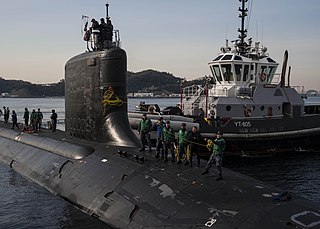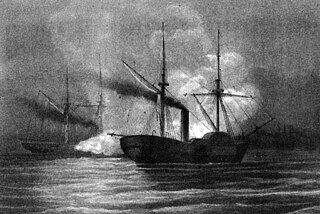
USS Texas (SSN-775) is a Virginia-class submarine, and the fourth warship of the United States Navy to be named after the US state of Texas.

The first USS Hatteras was a 1,126-ton iron-hulled steamer purchased by the Union Navy at the beginning of the American Civil War. She was outfitted as a gunboat and assigned to the Union blockade of the ports and waterways of the Confederate States of America. During an engagement with the disguised Confederate commerce raider, CSS Alabama, she was taken by surprise and was sunk off the coast of Galveston, Texas. The wreck site is one of the few listed on the National Register of Historic Places because of its location away from destructive surf and because of the ship's side-wheel design, which marks the transition between wooden sailing ships and steam-powered ships.
William Bainbridge Renshaw was an officer in the United States Navy during the American Civil War. He was killed during the Second Battle of Galveston.
Edward Lea was an officer in the United States Navy during the American Civil War. He was mortally wounded at the Battle of Galveston and died in the arms of his father, who was on the opposing side in the conflict.

Harriet Lane was a revenue cutter of the United States Revenue Cutter Service and, on the outbreak of the American Civil War, a ship of the United States Navy and later Confederate States Navy. The craft was named after the niece of senator and later United States President, James Buchanan; during his presidency, she acted as First Lady. The cutter was christened and entered the water for the Revenue Service in 1859 out of New York City, and saw action during the Civil War at Fort Sumter, New Orleans, Galveston, Texas, and Virginia Point. The Confederates captured her in 1863, whereupon she was converted to mercantile service. Union forces recaptured her at the end of war. The U.S. Navy declared her unfit for service and sold her. New owners out of Philadelphia renamed her Elliot Ritchie. Her crew abandoned her at sea in 1881.
USS Westfield was a sidewheel steam ferryboat in the United States Navy during the American Civil War.

The Battle of Galveston was a naval and land battle of the American Civil War, when Confederate forces under Major Gen. John B. Magruder expelled occupying Union troops from the city of Galveston, Texas on January 1, 1863.

Texas declared its secession from the Union on February 1, 1861, and joined the Confederate States on March 2, 1861, after it had replaced its governor, Sam Houston, who had refused to take an oath of allegiance to the Confederacy. As with those of other states, the Declaration of Secession was not recognized by the US government at Washington, DC. Some Texan military units fought in the Civil War east of the Mississippi River, but Texas was more useful for supplying soldiers and horses for the Confederate Army. Texas' supply role lasted until mid-1863, when Union gunboats started to control the Mississippi River, which prevented large transfers of men, horses, or cattle. Some cotton was sold in Mexico, but most of the crop became useless because of the Union's naval blockade of Galveston, Houston, and other ports.

The First Battle of Sabine Pass, also known as the Bombardment of Fort Sabine, was the first American Civil War bombardment by the United States Navy of a Confederate fort below Sabine City It was the apex in a series of naval and land skirmishes around the mouth of the Sabine River, Texas, and preceded by four weeks the Union Navy's first armed entry into Galveston Bay called the Battle of Galveston Harbor. Besides strengthening the Union naval blockade of the Texas coastline, the shelling and capture of Sabine Pass was to deter Confederate ground forces from moving southwestward on the Texas coast to augment Galveston's defense. It was intended to open the way for the Union invasion of Texas, which almost a year later, was attempted by a combined force of Union naval and army forces at the Second Battle of Sabine Pass.

C.S. Army Gunboat Bayou City (1861–1865) was a 165-foot side-wheel steamboat built for commercial use at Jeffersonville, Indiana, in 1859.

C.S. Army Tug Neptune was a wooden tugboat taken over by the Confederate States Army in about 1862 for the Texas Marine Department. She was employed as a tug, transport, and lookout vessel in the vicinity of Galveston, Texas.

The Battle of Galveston Harbor was fought at Galveston, Texas on October 4, 1862, during the American Civil War. After attempts to blockade the Texas coastline were unsuccessful, the Union Navy decided to attempt to capture the port of Galveston. While Galveston was defended by Confederate forces, most of the cannons in the city's defenses were removed, as Galveston was thought to be indefensible. On October 4, five Union naval vessels commanded by Commander William B. Renshaw approached Galveston, and a single ship, USRC Harriet Lane was sent into Galveston Bay under a flag of truce.

USS Clifton was a shallow-draft side-wheel paddle steamer, built in 1861 at Brooklyn, as a civilian ferry. The Union Navy bought her early that December, and commissioned her after having her converted into a gunboat. In 1863 she ran aground, was captured and commissioned into the Texas Marine Department. Her career ended in 1864 when she ran aground and her Confederate crew burned her to prevent her recapture.
Cottonclads were a classification of steam-powered warships where a wooden ship was protected from enemy fire by bales of cotton lining its sides. Cottonclads were prevalent during the American Civil War, particularly in the Confederate States Navy for riverine and coastal service such as in the battles of Memphis, Galveston, and Sabine Pass. Confederate tactics generally had cottonclads, which were outgunned by Union warships, steam at full speed towards enemy vessels, relying on the cotton to absorb fire. Once they were within firing range, they would open fire, and, if possible, ram or board the enemy.
USS Corypheus was a schooner captured by the Union Navy during the American Civil War.
The 141st Infantry Regiment is an infantry regiment in the United States Army. The lineage of the 141st includes units tracing origins to the Texas Revolution, such as Company A, First Texas, 1836, and other infantry companies of the First Texas formed in the 1870s and 1880s.

The action off Galveston Light was a short naval battle fought during the American Civil War in January 1863. Confederate raider CSS Alabama encountered and sank the United States Navy steamer USS Hatteras off Galveston Lighthouse in Texas.
The Texas Marine Department (1861–1865) was formed in the State of Texas shortly after Texas came under blockade from the Union Navy in 1861. It operated under the control of the Confederate Navy during the Civil War.
Colonel William Lewis Moody Sr. was an American entrepreneur who founded the Moody dynasty in Galveston, Texas. He participated in the Civil War on the side of the Confederacy. On January 19, 1860, he married Pherabe Elizabeth (Lizzie) Bradley. He is noted for persuading federal and local government to dredge Galveston's harbor, which led to Galveston becoming a prominent shipping port of the 19th century. He was survived by his son, William Lewis Moody Jr.

Leonidas R. Smith was an American steamboat captain and soldier. In the American Civil War he served the Confederate States of America as a volunteer; he was named Commander of the Texas Marine Department under General John B. Magruder. Smith was involved in most major conflicts along the Texas coast during the war, and was described by war-time governor of Texas Francis Lubbock as "undoubtedly the ablest Confederate naval commander in the Gulf waters".








